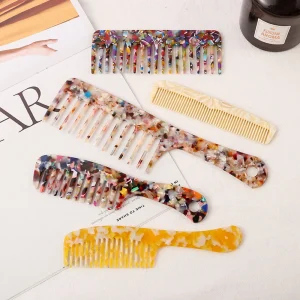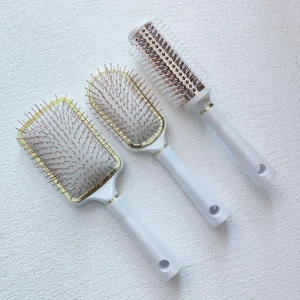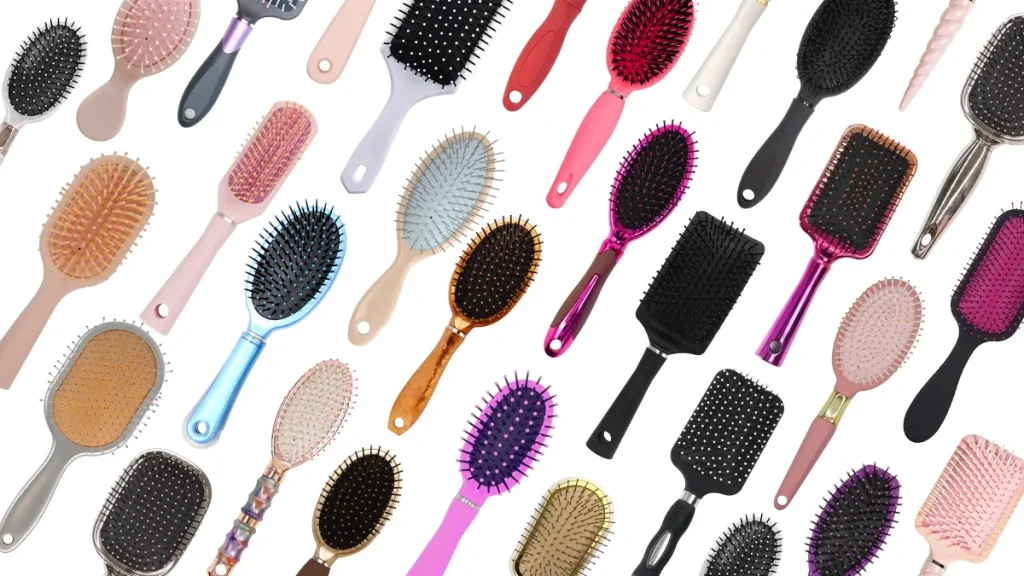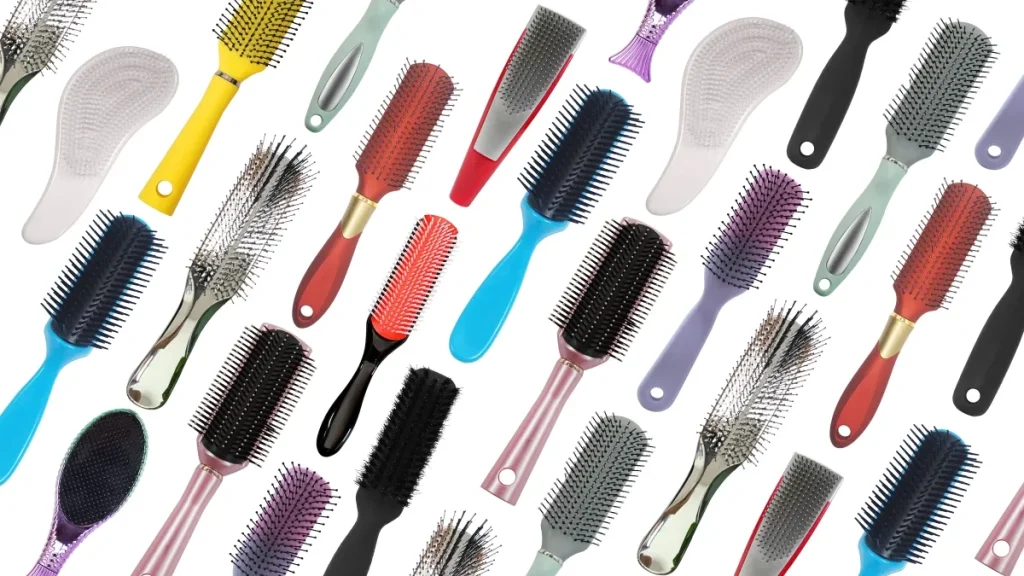Have you ever asked yourself whether you have been using the perfect hair tool? Although they may appear simple, they are very impactful when it comes to the health, smoothness, and style of your hair. Every morning, you depend on these tools to comb the tangles out of your hair and style it for the day. Keep in mind that these hair tools are unique to hair type.
However, calm down! In this guide, we’ll discuss comb vs brush in detail. Thus, you can make an informed decision on which one will work best for your type of hair. So, your hair care is just a few steps away!
1) Core Differences Between Combs and Brushes
Some people prefer using brushes while others can’t seem to get over combs, thus each side offers a favourable argument. Just like any other tool, both hair tools have their unique features, each serving different purposes. Let us take a look!
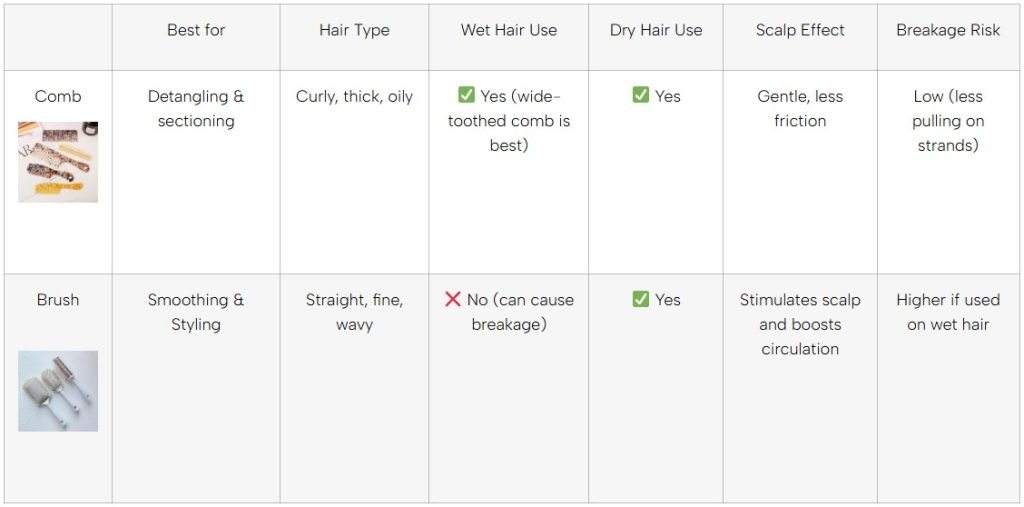
Best for | Hair Type | Wet Hair Use | Dry Hair Use | Scalp Effect | Breakage Risk | |
Comb
| Detangling & sectioning | Curly, thick, oily | ✅ Yes (wide-toothed comb is best) | ✅ Yes | Gentle, less friction | Low (less pulling on strands) |
Brush
| Smoothing & Styling | Straight, fine, wavy | ❌ No (can cause breakage) | ✅ Yes | Stimulates scalp and boosts circulation | Higher if used on wet hair |
i) Comb: The Precision Expert
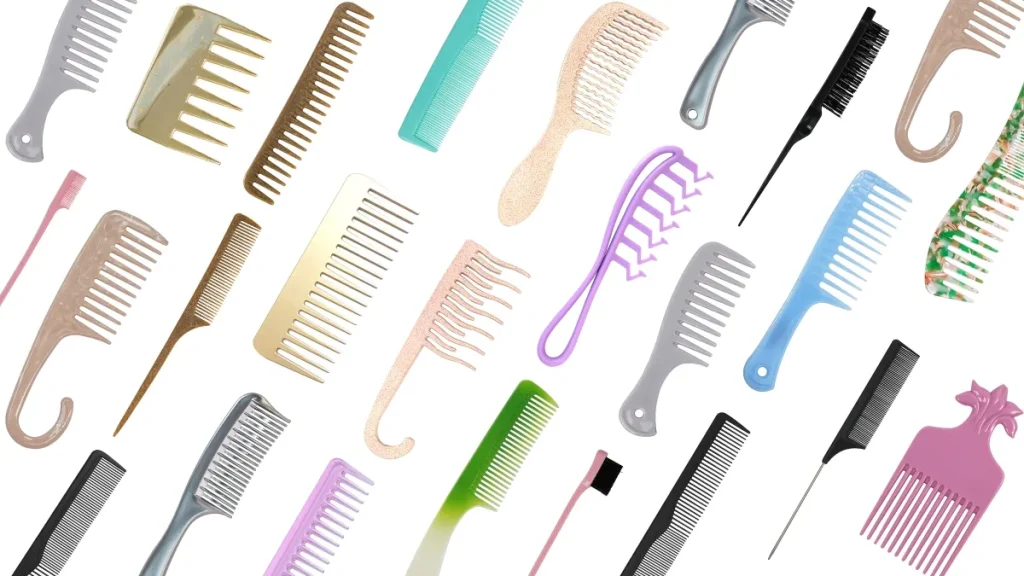
When it comes to styling your hair, a comb is more effective than a brush as it provides greater control and enables easier untangling. The gaps in the teeth of the comb lessen friction, which is a good thing for your strands. If you want maximum precision with minimal breakage, a comb is the right option.
➔ Comb Benefits
- Decreases breakage: There is no doubt that hair is at its weakest when wet. So, utilizing a wide-toothed comb, which does not exert too much pulling force on the hair, will help protect the keratin structure.
- Great for styling: Combs allow you to part your hair neatly and are perfect for braids, updos, and other sleek hairstyles. Thus, it is ideal for step-by-step styling with precision.
- Wide-tooth comb: Ideal choice for thick, curly, and coily hair detangling.
- Fine-tooth comb: Ideal for bringing hair into a sleek style and precise parting.
- Rat-tail comb: Assists in achieving clean sections for hairstyling.
ii) Brush: The Booster of Shine
A brush not only detangles but also redistributes the natural oils (sebum) your hair produces to make it softer and shinier. When brushing hair, the scalp also receives a gentle massage, which encourages blood flow and nourishes follicles, enabling better hair growth.
➔ Brush Benefits
- Enhances natural shine: Sebum your scalp releases and moisturizes hair, while the brush aids in accurately distributing it, thus ensuring optimal hydration and gloss.
- Anti-frizz: Some brushes, especially boar bristle brushes, help lessen static, which in turn helps maintain hair smoothness.
- Improved blood circulation: Hair brushing is a gentle but effective method of massaging the scalp, thereby increasing the blood circulation to hair follicles and strengthening them.
- Paddle brush: Optimal for straight, long hair; helps minimize hair tugging.
- Round brush: Creates bounce and curls when used with heat or styling tools.
- Boar bristle brush: A brush that stylists use to achieve shine and smooth hair by distributing the hair’s naturally occurring oils.
Now, if you have made up your mind and want to buy either a hair comb or brush, then look no further than Junyi Beauty. We provide customized hair care tools and have 25 years + manufacturing experience. So, go and visit our website today!
2) Choosing the Right Hair Type Tools
Using the right tool can maintain your hair’s structure, while the wrong tool can lead to breakage, frizz, or, over time, severe hair fall. With that in mind, let us help you choose the comb that is suitable for your hair!

➔ Quick Glance

Hair Type | Recommended Tool | Why it works |
Curly Hair
| ● Wide-tooth comb | ● Detangles gently prevents frizz and protects the natural curl pattern. |
Straight Hair | ● Boar bristle brush | ● Distributes natural oils evenly, smooths hair, and reduces static. |
Thick Hair | ● Wide-toothed comb or paddle brush | ● Reduces tension, makes detangling easier, and prevents breakage. |
Fine Hair | ● Round brush | ● Adds volume, lifts roots, and prevents flatness. |
i) For Curly Hair – Keep the Bounce, Skip the Frizz!
You know the spiral shape of the curly hair shaft will slow down how fast the natural essential oils released by the scalp reach the tips of the hair strands. This is the primary reason why curly hair requires additional care and gentle disentanglement to prevent damage.
➔ The recommended tool:
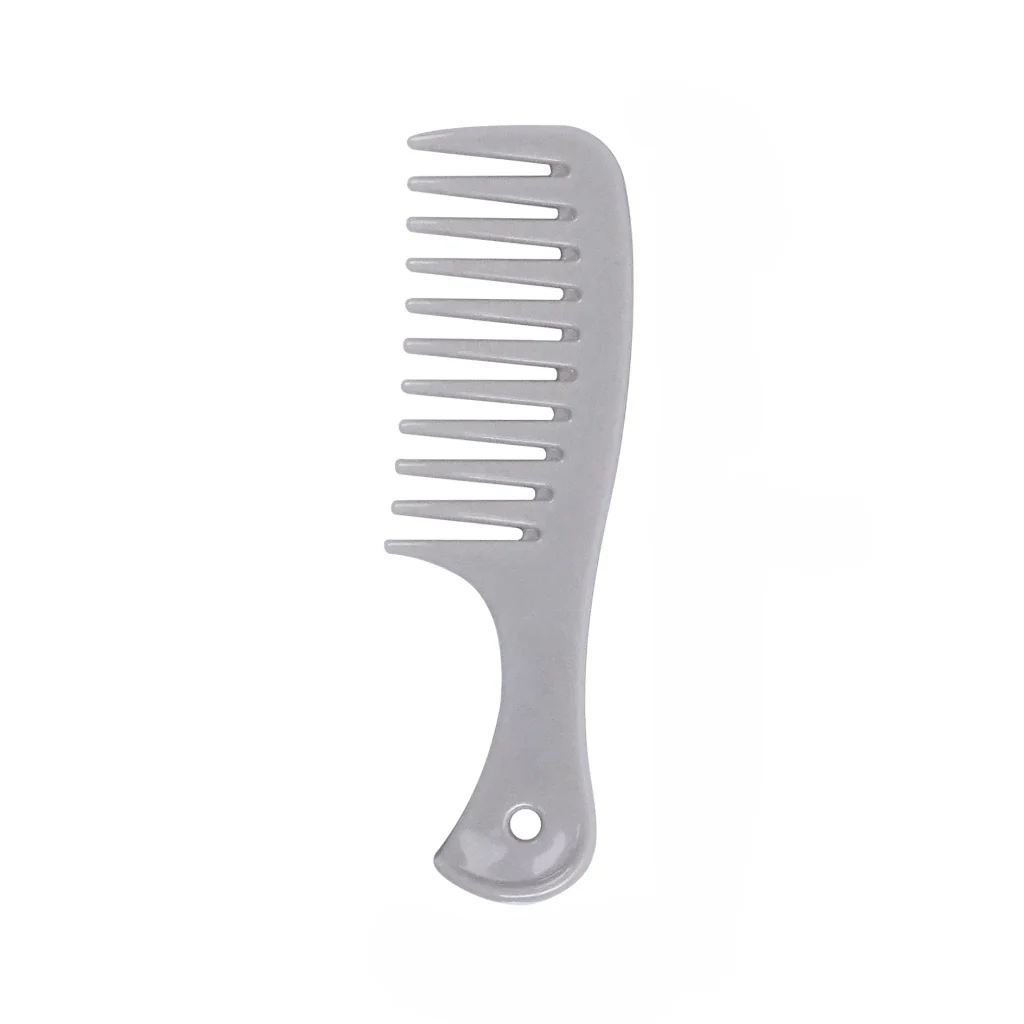
- A wide-toothed comb for curly hair is the best option. It reduces pulling or disruption and enhances moisture balance.
- ? Tip: Don’t seek brushes. They are rough and will destroy curl patterns and lead to more frizz.
ii) For Straight Hair – Shine and Sleekness Matter!
You know, straight hair doesn’t tend to retain moisture as much. Instead, straight hair tends to get oily much quicker because sebum (natural scalp oil) moves down the hair shaft easily. It can suffer from static, flyaways and lack of volume too.
➔ The recommended tool:

- Therefore, a boar bristle brush for straight hair is highly recommended. It helps sebum to get evenly distributed, which prevents greasy roots and dry ends. Moreover, the brush smooths the cuticle layer of the hair, making the hair shinier and free of frizz.
- ? Tip: Don’t use fine-tooth combs! These can cause aggressive static buildup, increasing the chance of being frizzy and tangled.
iii) For Thick Hair - Maintain the Volume Without Damage!
Thick hair is dense and strong but this type of hair requires more work when it comes to detangling and styling. The wrong styling tool can cause an incredible amount of stress to the hair fibres, leading to excessive shedding and breakage.
➔ The recommended tool:
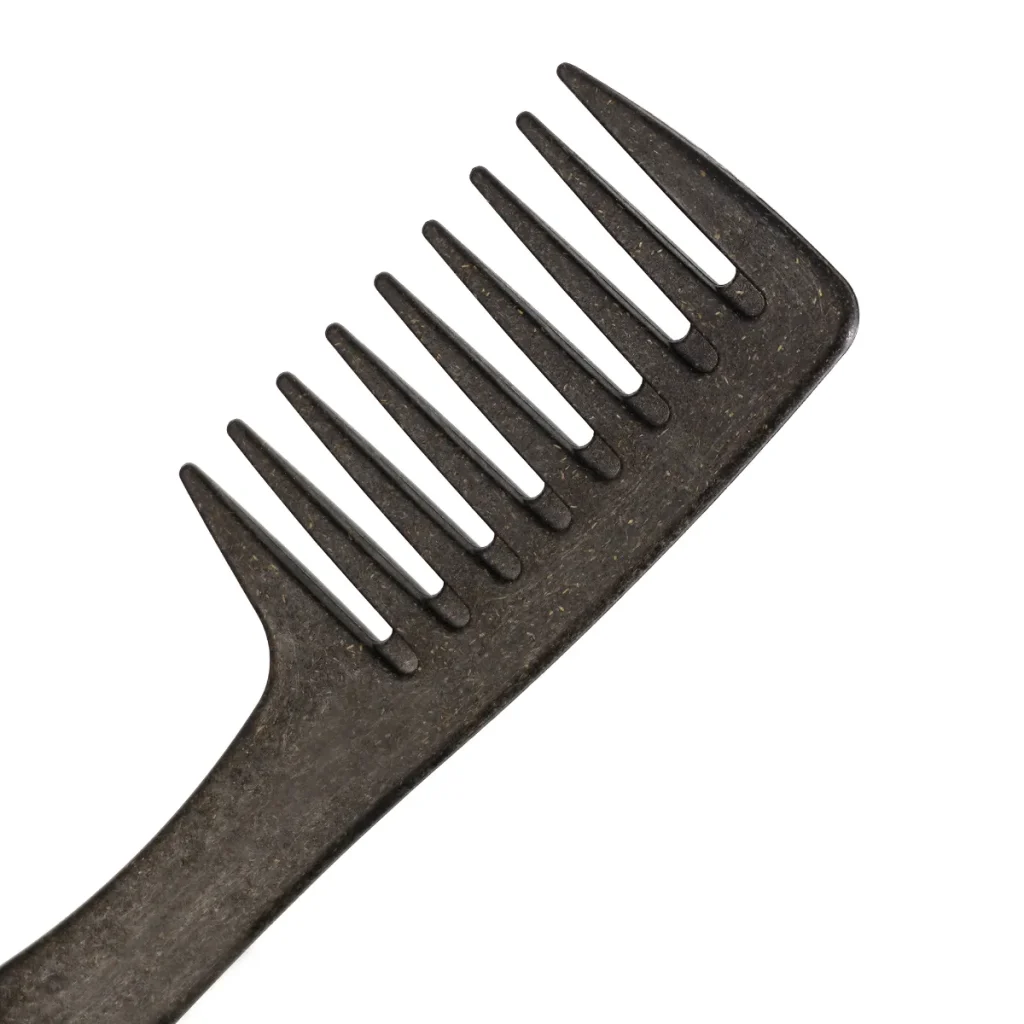
- Each strand of hair has high tensile strength, from 100-150 grams for each strand, but using excessive force from tight brushing can weaken the hair shaft. That’s why a wide-toothed comb is preferred. It reduces pulling and tugging while detangling the hair. Moreover, you can also use a paddle brush, which covers more hair at one time, making styling quick and efficient.
- ? Tip: Stay away from small brushes with hard bristles! They cause tugging and weakening of strands, which leads to hair breakage in the long run.
iv) For Fine Hair – Add Volume Without Weighing It Down!
Fine hair is fragile, has little volume, and breaks easily. So, the right tool is necessary to lift and add volume to the hair.
➔ The recommended tool:
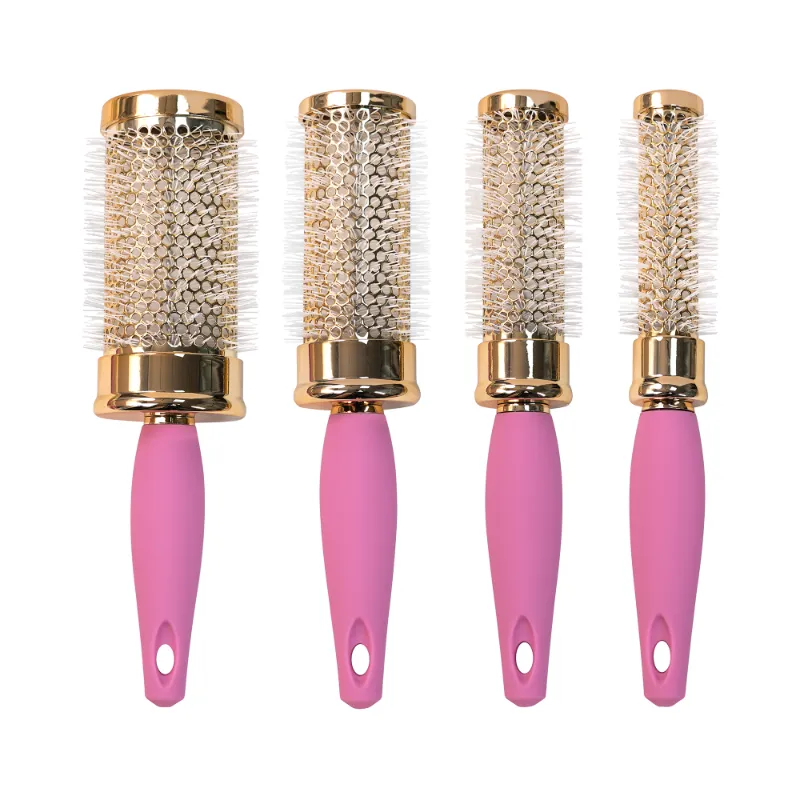
- Keep in mind that fine hair is thinner in diameter (50-70 microns) than thick hair (120+ microns). Thus, a round brush allows for mild styling while still offering adequate grip for lift. Moreover, it helps to maintain a certain shape and movement by keeping heat trapped while blow-drying.
- ? Tip: Stay away from heavy brushes or wide-tooth combs! Such tools will not result in the fine hair lift needed.
3) Additional Factors to Consider When Choosing the Right Hair Tool
You now understand that a brush or comb selection is based on your specific hairstyle. But there is more to consider! The material, your scalp condition, and the time of use are just as important. So, let’s get started!
i) Hair Comb Materials Matter
Not all combs and brushes are alike. Their material influences their durability, their performance with your hair, and the surface you are using them on.
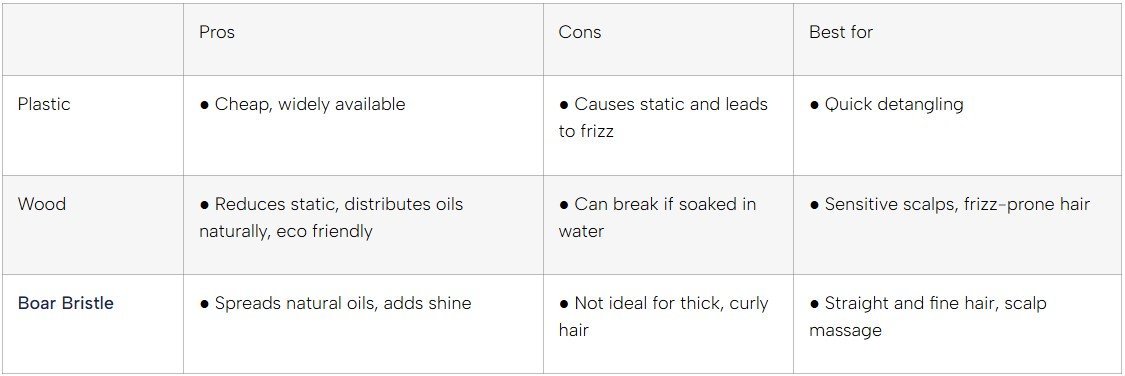
Pros | Cons | Best for | |
Plastic | ● Cheap, widely available | ● Causes static and leads to frizz | ● Quick detangling |
Wood | ● Reduces static, distributes oils naturally, eco friendly | ● Can break if soaked in water | ● Sensitive scalps, frizz-prone hair |
● Spreads natural oils, adds shine | ● Not ideal for thick, curly hair | ● Straight and fine hair, scalp massage |
ii) Scalp Health
Moreover, the scalp is the foundation for strong and healthy hair. So, keeping it clean and stimulated with the correct tools ensures it is in top form. Additionally, blood circulation improvement and an increase in growth rate can be achieved with soft-bristled scalp massaging brushes. Do remember! Sensitive scalps benefit more from wide-tooth combs, which do not scrape or irritate the scalp.
iii) Usage Scenarios
Last but not least, different tools are better suited for different scenarios. So, maintaining proper tool use ensures that the hair remains healthy.
- For Wet Hair: Using a brush is ill-advised when hair is wet. Instead, wide-tooth combs are the best option as they gently remove tangles without pulling or snapping fragile strands.
- For Dry Hair: If seeking dry hair and adding smoothness, shine, or volume, use a brush. They aid in the distribution of natural scalp oils from the roots to the ends, thus preventing dry, frizzy hair.
Do remember! When your hair is dry, then combing can stretch up to 20%, and when wet, it stretches up to 50%. This is the reason why rough wet hair combing leads to damage. It is recommended to use a comb after washing.
4) Common Mistakes and How to Fix Them
Even the tiniest errors in a haircare routine can result in breakage, frizz, or scalp issues. Don’t worry, in this section, we’ll discuss common hair tool mistakes and their solutions.
i) Using the Wrong Tool
An individual’s hair type determines whether they uses a comb or a brush. Fine-tooth combs are an impossible feat for thick and curly hair due to the tangles and breakage associated with it. Regular brushes also pose a threat to those with wet hair due to warm, elastic strands.
➔ Solution:
A wide-toothed comb will work best for detangling curly hair. Smoothing straight or fine hair calls for the use of a boar bristle brush.
ii) Not Cleaning Your Comb or Brush
Every time a brush is used, it collects remnants of dust, oil, and skin cells. The accumulation over time leads to bacteria growth which gets transferred to the scalp. A brush that is not cleaned regularly tends to itch, get dandruff, and have scalp infections.
➔ Solution:
Remove trapped hair from the brush and wash it with soapy warm water. So, clean your hair comb or brush once a week. It keeps the scalp fresh and prevents bacterial buildup. Moreover, for further info related to how to clean your hair brush or combs, you can visit our website.
iii) Brushing Hair Too Often or Too Nicely
Some people feel that aggressive brushing will remove knots more quickly, but it only tears the hair shaft and leads to breakage. Evenly spaced strides work, but so does over-brushing—it removes the natural oils and moisture from your hair, making it excessively dry and prone to frizz putting undue strain and making curly hair worse.
➔ Solution:
Always start at the end and work your way up slowly. Don’t exceed two bristles a day while keeping the bow tidy to mitigate shine loss.
5) Conclusion:
Now you know that choosing the perfect hair tool possesses transformative power! A wide-toothed comb secures your strands while boar bristle combs glide over your scalp. Whether you have curly, straight, fine, or thick hair, the perfect hair tool will keep your healthy. S, if you are in search of high-quality and affordable hair care tools, then your search seems to be over here. We at Junyi Beauty manufacture customized hair care tools including combs, brushes, hair clips, and electric hair styling tools. So, contact us today!


